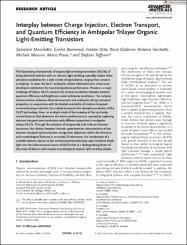| dc.contributor.author | Moschetto, Salvatore | |
| dc.contributor.author | Benvenuti, Emilia | |
| dc.contributor.author | Usta, Hakan | |
| dc.contributor.author | Özdemir, Resul | |
| dc.contributor.author | Facchetti, Antonio | |
| dc.contributor.author | Muccini, Michele | |
| dc.contributor.author | Prosa, Mario | |
| dc.contributor.author | Toffanin, Stefano | |
| dc.date.accessioned | 2022-07-01T08:34:57Z | |
| dc.date.available | 2022-07-01T08:34:57Z | |
| dc.date.issued | 2022 | en_US |
| dc.identifier.issn | 2196-7350 | |
| dc.identifier.other | WOS:000742745500001 | |
| dc.identifier.uri | https://doi.org/10.1002/admi.202101926 | |
| dc.identifier.uri | https://hdl.handle.net/20.500.12573/1306 | |
| dc.description.abstract | The fascinating characteristic of organic light-emitting transistors (OLETs) of being electrical switches with an intrinsic light-emitting capability makes them attractive candidates for a wide variety of applications, ranging from sensors to displays. To date, the OLET ambipolar trilayer heterostructure is the most developed architecture for maximizing device performance. However, a major challenge of trilayer OLETs remains the inverse correlation between external quantum efficiency and brightness under ambipolar conditions. The complex interconnection between electroluminescent and ambipolar charge transport properties, in conjunction with the limited availability of electron transport semiconducting materials, has indeed hampered the disruptive evolution of the OLET technology. Here, an in-depth study of the interplay of the key fundamental features that determine the device performance is reported by exploring electron transport semiconductors with different properties in ambipolar trilayer OLETs. Through the selection of compounds with tailored chemical structures, the relation between intrinsic optoelectronic characteristics of the electron transport semiconductor, energy level alignment within the structure, and morphological features is unraveled. Furthermore, the introduction of a suitable electron injector at the emissive/semiconducting layers interface sheds light into the bidimensional nature of OLETs that is a distinguishing factor of this class of devices with respect to prototypical organic light-emitting diodes. | en_US |
| dc.description.sponsorship | European Union's Horizon 2020 Research and Innovation Programme *Grant number:101016706 | en_US |
| dc.language.iso | eng | en_US |
| dc.publisher | WILEY | en_US |
| dc.relation.isversionof | 10.1002/admi.202101926 | en_US |
| dc.rights | info:eu-repo/semantics/openAccess | en_US |
| dc.subject | ambipolar trilayer heterostructure | en_US |
| dc.subject | electron injection layer | en_US |
| dc.subject | external quantum efficiency | en_US |
| dc.subject | n-type organic semiconductors | en_US |
| dc.subject | organic light-emitting transistors | en_US |
| dc.subject | wide area emission | en_US |
| dc.title | Interplay between Charge Injection, Electron Transport, and Quantum Efficiency in Ambipolar Trilayer Organic Light-Emitting Transistors | en_US |
| dc.type | article | en_US |
| dc.contributor.department | AGÜ, Mühendislik Fakültesi, Malzeme Bilimi ve Nanoteknoloji Mühendisliği Bölümü | en_US |
| dc.contributor.authorID | 0000-0003-4099-8664 | en_US |
| dc.contributor.authorID | 0000-0001-5533-1585 | en_US |
| dc.contributor.authorID | 0000-0002-7957-110X | en_US |
| dc.contributor.institutionauthor | Usta, Hakan | |
| dc.identifier.volume | 9 | en_US |
| dc.identifier.issue | 5 | en_US |
| dc.identifier.startpage | 1 | en_US |
| dc.identifier.endpage | 11 | en_US |
| dc.relation.journal | ADVANCED MATERIALS INTERFACES | en_US |
| dc.relation.publicationcategory | Makale - Uluslararası Hakemli Dergi - Kurum Öğretim Elemanı | en_US |


















